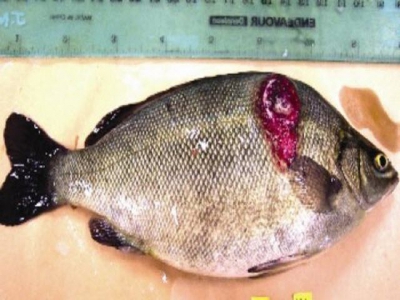Epizootic Ulcerative Syndrome (Red Spot Disease)

What is it?
Epizootic ulcerative syndrome (EUS), also known as red spot disease (RSD) and mycotic granulomatoses (MG), is a seasonal epizootic condition of great importance in wild and farmed freshwater and estuarine fish.
It was first reported in farmed ayu (Plecoglossus altivelis) in Japan in 1971. It was later reported in estuarine fish, particularly grey mullet in eastern Australia in 1972.
The fungus involved in EUS is also known variously as Aphanomyces invadans, A. piscicida, A. invaderis and ERA (EUS-related Aphanomyces) . Rhabdoviruses have also been associated with particular outbreaks, and secondary Gram-negative bacteria invariably infect EUS lesions.
Where and When Might it Occur?
The outbreak has extended its range through Papua New Guinea into South-East and south Asia, and recently into west Asia, where it has now reached Pakistan.
Outbreaks of ulcerative disease in menhaden (Brevoortia tyrannus) in the United States of America have been shown to be very similar to EUS in Asia.
Region-wide, over 50 species of fish have been confirmed by histological diagnosis to be affected by EUS, but some important culture species, including tilapia, milk fish and Chinese carp, have been shown to be resistant.
EUS occurs mostly during periods of low temperatures and after periods of heavy rainfall. These conditions favour sporulation of Aphanomyces invadans, and low temperatures have been shown to delay the inflammatory response of fish to fungal infection.
EUS is transmitted from one fish to another through the water supply.
The susceptible life stages of the fish are usually juvenile and young adults. There is no report of EUS being found in fish fry or fish larvae
Diagnosis
When EUS spreads into a fish culture pond, high morbidity (>50%) and high mortality (>50%) might be observed in those years that have a long cold season, with water temperatures between 18 and 22C. Some infected fish may recover when the cold period is over.
EUS can be readily detected in diseased fish specimens collected from EUS-infected areas using histological techniques. Fish may exhibit red spots or small ulcers.
There is no information to indicate that fish can be lifelong carriers of A. invadans. Generally, most infected fish die during an outbreak. Although some mild or moderate EUSinfected fish could recover, they are unlikely to be lifelong carriers.
Control/Treatment
Control of EUS in natural waters is probably impossible. In outbreaks occurring in small, closed water-bodies, liming water and improving water quality, together with removal of infected fish, is often effective in reducing mortalities.
Có thể bạn quan tâm
 A slice of genius
A slice of genius A Brazilian aquaculture technology firm has unveiled an innovative production system for farming tilapia - in Brazil and beyond.
 White Spot Disease
White Spot Disease White spot is a contagious parasitic disease of fish. Caused by Ichyophthirius multifilis, the parasite infects the fish after moving from the bottom of the pon
 Spring Viraemia of Carp
Spring Viraemia of Carp Spring viraemia of carp (SVC) is an infectious viral disease of carp (Cyprinus carpio) and other cyprinid fish species